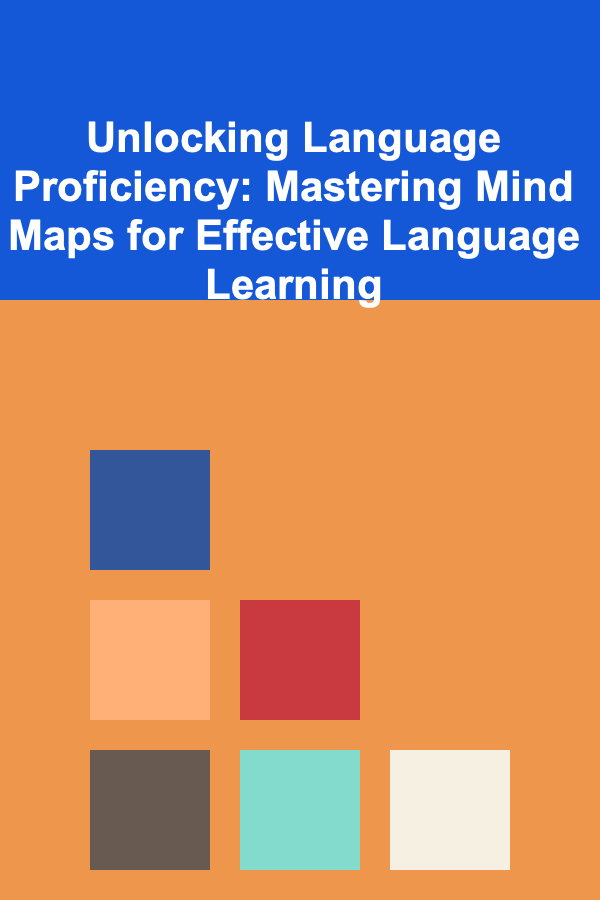
Unlocking Language Proficiency: Mastering Mind Maps for Effective Language Learning
ebook include PDF & Audio bundle (Micro Guide)
$12.99$8.99
Limited Time Offer! Order within the next:

Learning a new language can be a daunting but rewarding journey. The sheer volume of vocabulary, grammar rules, and cultural nuances can feel overwhelming. Traditional methods, such as rote memorization and repetitive exercises, often prove inefficient and demotivating. However, a powerful alternative exists: the mind map. This article explores how to effectively utilize mind maps as a potent tool for language learning, transforming the learning process from a chore into an engaging and stimulating experience.
The Power of Visual Learning and Mind Mapping
The human brain is inherently visual. We process images and spatial information much more efficiently than linear text. Mind maps leverage this natural cognitive ability by presenting information in a visually organized and interconnected manner. A mind map is a diagram used to visually organize information. It is typically created around a single concept, drawn as an image in the center of a blank page, to which associated representations of ideas such as images, words and parts of words are added. Major ideas are connected directly to the central concept, and other ideas branch out from those major ideas.
This non-linear structure allows for a more holistic understanding of the subject matter. Instead of passively absorbing isolated facts, learners actively engage with the information, creating connections and relationships that enhance retention and recall. Mind maps tap into the brain's associative thinking patterns, making learning more intuitive and enjoyable.
Key benefits of using mind maps for language learning include:
- Improved Memory Retention: Visual associations and spatial organization aid in long-term memory formation.
- Enhanced Comprehension: The interconnected structure fosters a deeper understanding of concepts and their relationships.
- Increased Creativity: The brainstorming nature of mind mapping encourages creative thinking and problem-solving.
- Improved Organization: Mind maps provide a clear and structured overview of complex topics.
- Increased Motivation: The visual and engaging nature of mind maps makes learning more enjoyable and less tedious.
Creating Effective Language Learning Mind Maps: A Step-by-Step Guide
Creating effective mind maps for language learning requires a systematic approach. Here's a detailed guide to help you get started:
1. Choose a Central Topic:
Every mind map revolves around a central topic. This could be a specific grammar rule (e.g., "Past Tense"), a vocabulary theme (e.g., "Food"), a cultural concept (e.g., "Japanese Etiquette"), or a communication skill (e.g., "Making Requests"). Select a topic that is relevant to your learning goals and that you want to explore in detail.
2. Start with a Central Image:
Instead of simply writing the topic name, represent it with a central image. Images are more memorable and engaging than text. For example, if your topic is "Food," you could draw a simple picture of a plate with various food items. The image should be visually appealing and relevant to the topic.
3. Add Main Branches:
From the central image, draw thick branches representing the main subtopics or categories related to the central topic. These branches should be curved and colorful to make them more visually appealing. For example, if your central topic is "Food," your main branches could be "Fruits," "Vegetables," "Meat," "Grains," and "Desserts."
4. Develop Sub-Branches:
From each main branch, draw thinner sub-branches representing more specific details and examples. Use keywords and short phrases instead of long sentences. For example, from the "Fruits" branch, you could have sub-branches like "Apple," "Banana," "Orange," "Grape," and "Strawberry." For each fruit, you could add even more specific sub-branches with details like color, taste, and nutritional value.
5. Use Keywords and Images:
Whenever possible, use keywords and images instead of long sentences. This helps to keep the mind map concise and visually stimulating. Images are particularly helpful for representing abstract concepts or vocabulary words that are difficult to visualize. For example, for the word "delicious," you could draw a picture of someone enjoying a meal.
6. Color-Code Your Mind Map:
Use different colors for each main branch and its sub-branches. Color-coding helps to visually organize the information and makes the mind map easier to navigate. For example, you could use green for "Vegetables," red for "Meat," and yellow for "Fruits."
7. Connect Ideas with Lines and Arrows:
Draw lines and arrows to connect related ideas within the mind map. This helps to show the relationships between different concepts and promotes a deeper understanding of the subject matter. For example, you could draw an arrow from "Fruits" to "Vitamins" to show that fruits are a good source of vitamins.
8. Review and Revise Regularly:
Mind maps are not static documents. Review and revise them regularly to reinforce your learning and add new information. As you learn more about the topic, you can add new branches, sub-branches, and connections to the mind map. This iterative process helps to solidify your understanding and improve your memory retention.
9. Use Digital Tools:
While hand-drawn mind maps are a great way to get started, digital mind mapping tools offer several advantages, such as ease of editing, collaboration, and integration with other learning resources. Popular digital mind mapping tools include:
- MindMeister: A collaborative online mind mapping tool.
- XMind: A powerful desktop mind mapping software with a wide range of features.
- FreeMind: A free and open-source mind mapping tool.
- Coggle: A simple and intuitive online mind mapping tool.
- Microsoft Visio: A comprehensive diagramming tool that can also be used for mind mapping.
Specific Applications of Mind Maps in Language Learning
Mind maps can be applied to various aspects of language learning, from vocabulary acquisition to grammar comprehension and conversation practice. Here are some specific examples:
1. Vocabulary Building:
Mind maps are an excellent tool for expanding your vocabulary. Create a central image representing a specific theme, such as "Travel," "Work," or "Hobbies." Then, add branches for different words and phrases related to that theme. For each word, include its definition, synonyms, antonyms, and example sentences. You can also add images to help visualize the meaning of the words. This visual approach makes vocabulary learning more engaging and memorable.
Example:
- Central Image: A suitcase with travel stickers.
- Main Branches: "Transportation," "Accommodation," "Activities," "Food," "Culture."
- Sub-Branches (under "Transportation"): "Airplane" (definition, synonyms like "aeroplane," example sentence), "Train" (definition, synonyms, example sentence), "Bus" (definition, synonyms, example sentence), "Car" (definition, synonyms, example sentence).
2. Grammar Rules:
Grammar rules can be complex and difficult to grasp. Mind maps can help to simplify these rules by presenting them in a visual and organized manner. Create a central image representing the grammar rule, such as "Past Tense," "Conditional Sentences," or "Relative Clauses." Then, add branches for different aspects of the rule, such as its definition, usage, examples, and exceptions. Use color-coding to highlight different parts of the rule.
Example:
- Central Image: A clock pointing to a past time.
- Main Branches: "Definition," "Regular Verbs," "Irregular Verbs," "Usage."
- Sub-Branches (under "Regular Verbs"): "Adding -ed" (examples like "walked," "played," "studied"), "Spelling Rules" (examples like "stopped," "tried").
- Sub-Branches (under "Irregular Verbs"): A list of common irregular verbs and their past tense forms (e.g., "go - went," "eat - ate," "see - saw").
3. Conversation Practice:
Mind maps can be used to prepare for conversation practice by organizing key phrases and vocabulary related to a specific topic. Create a central image representing the conversation topic, such as "Ordering Food," "Asking for Directions," or "Making Introductions." Then, add branches for different phrases and questions that you might use in the conversation. You can also add branches for possible responses and follow-up questions. This will help you to feel more prepared and confident during your conversation practice.
Example:
- Central Image: Two people shaking hands.
- Main Branches: "Greetings," "Introducing Yourself," "Asking About Someone," "Ending the Conversation."
- Sub-Branches (under "Greetings"): "Hello," "Hi," "Good morning," "Good afternoon," "Good evening."
- Sub-Branches (under "Introducing Yourself"): "My name is...," "I am...," "Nice to meet you," "Pleased to meet you."
4. Understanding Cultural Concepts:
Learning a language is not just about learning words and grammar; it's also about understanding the culture of the people who speak the language. Mind maps can be used to explore cultural concepts and traditions. Create a central image representing the cultural concept, such as "Thanksgiving," "Chinese New Year," or "Japanese Tea Ceremony." Then, add branches for different aspects of the concept, such as its history, traditions, customs, and significance. Use images and anecdotes to bring the concept to life.
Example:
- Central Image: A Thanksgiving turkey.
- Main Branches: "History," "Traditions," "Food," "Significance."
- Sub-Branches (under "History"): "Pilgrims," "Native Americans," "First Thanksgiving."
- Sub-Branches (under "Traditions"): "Family gatherings," "Giving thanks," "Watching football."
5. Planning Writing Tasks:
Mind maps are invaluable for planning and organizing writing tasks, such as essays, reports, or stories. Use the central image to represent the main topic of your writing. The main branches can represent the different sections or paragraphs of your writing. Sub-branches can contain key ideas, supporting arguments, examples, and evidence. The visual structure helps to ensure a logical flow of ideas and prevents writer's block.
Advanced Mind Mapping Techniques for Language Learning
Once you've mastered the basics of mind mapping, you can explore advanced techniques to further enhance your language learning experience:
1. Using Analogies and Metaphors:
Analogies and metaphors can help to make abstract concepts more concrete and understandable. Incorporate analogies and metaphors into your mind maps to connect new information to what you already know. For example, you could use the metaphor of a "tree" to represent a language, with the "roots" representing the basic grammar and vocabulary, the "trunk" representing the core concepts, and the "branches" representing the different dialects and variations.
2. Incorporating Emotional Associations:
Emotional associations can significantly enhance memory retention. Connect vocabulary words and grammar rules to personal experiences and emotions. For example, if you're learning the word "happiness," you could associate it with a memory of a happy event in your life. This will make the word more meaningful and memorable.
3. Using Spaced Repetition Systems (SRS) with Mind Maps:
Spaced repetition is a learning technique that involves reviewing information at increasing intervals. Combine mind maps with SRS software, such as Anki, to optimize your learning and retention. Create flashcards based on the information in your mind maps and use the SRS software to schedule your reviews. This will ensure that you review the information at the optimal time to maximize your memory retention.
4. Collaborative Mind Mapping:
Collaborative mind mapping involves creating mind maps with other learners. This allows you to share ideas, learn from each other, and create more comprehensive and insightful mind maps. Use online mind mapping tools that support collaboration to work with other learners in real-time. This can be a fun and effective way to enhance your language learning experience.
5. Integrating Mind Maps with Other Learning Resources:
Mind maps should not be used in isolation. Integrate them with other learning resources, such as textbooks, online courses, and language exchange partners. Use mind maps to summarize and organize the information you learn from these resources. This will help you to consolidate your knowledge and improve your understanding of the subject matter.
Overcoming Challenges and Common Pitfalls
While mind mapping is a powerful tool, it's important to be aware of potential challenges and pitfalls and how to overcome them:
- Overly Complex Mind Maps: Avoid creating mind maps that are too complex and cluttered. Keep the branches and sub-branches concise and focused. If the mind map becomes too overwhelming, consider breaking it down into smaller, more manageable mind maps.
- Lack of Clarity: Ensure that the keywords, phrases, and images you use in your mind maps are clear and unambiguous. If you're not sure what a particular element means, it's unlikely that you'll be able to remember it later.
- Inconsistent Structure: Maintain a consistent structure throughout your mind map. This will make it easier to navigate and understand. Use the same color-coding scheme for all of your mind maps and follow a consistent format for adding branches and sub-branches.
- Neglecting Review and Revision: Mind maps are not static documents. Review and revise them regularly to reinforce your learning and add new information. If you neglect to review your mind maps, you're likely to forget the information they contain.
- Relying Solely on Mind Maps: Mind maps are a valuable tool, but they should not be used in isolation. Integrate them with other learning resources and activities to create a well-rounded learning experience.
Conclusion: Mind Maps -- A Powerful Ally in Language Learning
Mind mapping offers a dynamic and engaging approach to language learning, transforming the process from a rote memorization task into an active, creative, and visually stimulating experience. By embracing the principles of visual organization, associative thinking, and personalized connections, learners can unlock their full potential and achieve fluency with greater efficiency and enjoyment. So, embrace the power of mind maps and embark on a journey of language mastery like never before.

How Deep Learning Can Help You Make Passive Income Online
Read More
How to Create a Compact Home Gym That Saves Space
Read More
How to Declutter Your Home in 30 Days
Read More
How to Manage Debt Effectively and Build Your Credit Score
Read More
How to Stay Within Budget During Renovation
Read More
10 Tips for Visualizing Inspirational Quotes Effectively
Read MoreOther Products

How Deep Learning Can Help You Make Passive Income Online
Read More
How to Create a Compact Home Gym That Saves Space
Read More
How to Declutter Your Home in 30 Days
Read More
How to Manage Debt Effectively and Build Your Credit Score
Read More
How to Stay Within Budget During Renovation
Read More